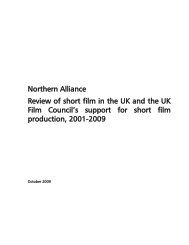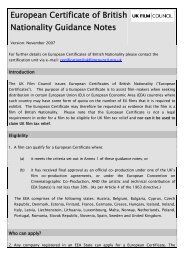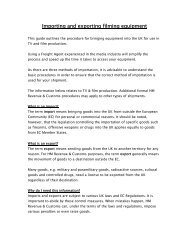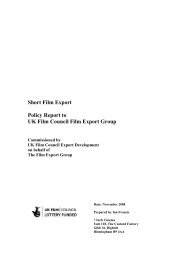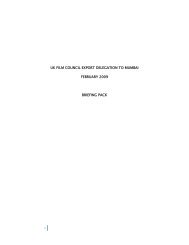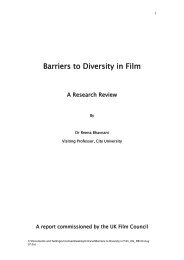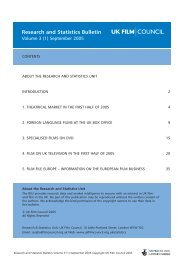Film theft in the UK - Future of Copyright
Film theft in the UK - Future of Copyright
Film theft in the UK - Future of Copyright
Create successful ePaper yourself
Turn your PDF publications into a flip-book with our unique Google optimized e-Paper software.
42<br />
successfully stop suspects try<strong>in</strong>g to record<br />
movies be<strong>in</strong>g screened <strong>in</strong> <strong>the</strong>ir c<strong>in</strong>emas.<br />
However, whe<strong>the</strong>r or not <strong>the</strong>se measures have<br />
been sufficient is open to debate. One need<br />
only look back at <strong>the</strong> mass <strong>of</strong> evidence<br />
suggest<strong>in</strong>g that movie titles are appear<strong>in</strong>g<br />
more and more, earlier and earlier, on P2P<br />
networks to question whe<strong>the</strong>r enough is be<strong>in</strong>g<br />
done (see Chapter 4 for an analysis <strong>of</strong> P2P<br />
movie fileshar<strong>in</strong>g).<br />
The <strong>UK</strong> film <strong>in</strong>dustry needs to conduct a<br />
thorough review <strong>of</strong> security risks and potential<br />
sources <strong>of</strong> ‘<strong>in</strong>ternal leaks’ <strong>in</strong> <strong>the</strong> preproduction,<br />
production, post-production and<br />
distribution process. Such a review could draw<br />
on lessons from <strong>the</strong> research undertaken by<br />
AT&T (discussed <strong>in</strong> chapter 4, ‘Sources <strong>of</strong><br />
<strong>in</strong>ternet piracy’).<br />
The <strong>Film</strong> Distributors’ Association (FDA) has<br />
already undertaken work <strong>in</strong> this area through<br />
its film pr<strong>in</strong>t work<strong>in</strong>g group that now <strong>in</strong>cludes<br />
<strong>the</strong> <strong>UK</strong> <strong>Film</strong> Council. For some time this group<br />
has been work<strong>in</strong>g towards improved<br />
procedures and an extensively revised <strong>Film</strong> Pr<strong>in</strong>t<br />
and Digital Disk Management Protocol was<br />
issued <strong>in</strong> July 2004.<br />
Controll<strong>in</strong>g content <strong>in</strong> <strong>the</strong><br />
digital doma<strong>in</strong><br />
There are several types <strong>of</strong> technologies that can<br />
help control copyright content <strong>in</strong> <strong>the</strong> digital<br />
doma<strong>in</strong>. The motivation is to keep content<br />
secure when it is stored on a device and when<br />
it is transferred <strong>in</strong> a digital format between<br />
devices. Ideally, <strong>the</strong>se solutions should enhance<br />
<strong>the</strong> bus<strong>in</strong>ess choices open to <strong>the</strong> rights owner<br />
as to how to exploit <strong>the</strong>ir content, while at <strong>the</strong><br />
same time maximis<strong>in</strong>g <strong>the</strong> control, choice and<br />
convenience for <strong>the</strong> consumer. This is <strong>of</strong>ten<br />
referred to as Digital Rights Management<br />
(DRM). However, many <strong>of</strong> <strong>the</strong> issues <strong>in</strong>volved <strong>in</strong><br />
<strong>the</strong> deployment <strong>of</strong> <strong>the</strong>se systems have been<br />
contentious, result<strong>in</strong>g <strong>in</strong> lengthy disputes<br />
between <strong>the</strong> content owners, regulators and<br />
consumer hardware manufacturers (<strong>the</strong> latter<br />
<strong>of</strong>ten present<strong>in</strong>g <strong>the</strong>ir case as <strong>the</strong> voice <strong>of</strong> <strong>the</strong><br />
consumer via organisations like <strong>the</strong> Home<br />
Record<strong>in</strong>g Rights Coalition).<br />
New digital TV sets and digital video devices<br />
launched <strong>in</strong>to <strong>the</strong> US market are <strong>in</strong>creas<strong>in</strong>gly<br />
<strong>in</strong>corporat<strong>in</strong>g secure <strong>in</strong>terfaces that allow<br />
content to be securely transferred from one<br />
device to ano<strong>the</strong>r. As far as record<strong>in</strong>g is<br />
concerned, content owners and digital<br />
broadcasters have <strong>the</strong> facility to apply vary<strong>in</strong>g<br />
‘usage rules’ to content travell<strong>in</strong>g over <strong>the</strong><br />
digital connections. The three basic levels are:<br />
Copy Freely: broadcast signals that are<br />
provided to viewers free <strong>of</strong> charge can be<br />
recorded by digital mach<strong>in</strong>es much like VCRs<br />
do at present.<br />
Copy Once: Pay-TV subscription programm<strong>in</strong>g<br />
such as <strong>the</strong> BSkyB movie channels <strong>in</strong> <strong>the</strong> <strong>UK</strong>, or<br />
HBO and Showtime <strong>in</strong> <strong>the</strong> US, can be set to<br />
only be recordable once for archiv<strong>in</strong>g purposes,<br />
but prevent<strong>in</strong>g additional copies from be<strong>in</strong>g<br />
made.<br />
Copy Never: Aimed at pay-per-view (PPV) and<br />
video-on-demand (VoD) service providers,<br />
programmes can be set so as to not to be<br />
recordable by a digital home recorder.<br />
There are many contentious issues still be<strong>in</strong>g<br />
debated, particularly <strong>in</strong> <strong>the</strong> US. These <strong>in</strong>clude<br />
<strong>the</strong> proposal to protect digital free TV from<br />
unauthorised redistribution via <strong>the</strong> Internet<br />
us<strong>in</strong>g a so-called Broadcast Flag. This would<br />
<strong>in</strong>sert a trigger signal <strong>in</strong> digital broadcasts that<br />
could be used to limit <strong>the</strong> record<strong>in</strong>g and<br />
retransmission capability <strong>of</strong> free TV<br />
programm<strong>in</strong>g. The controversial dimension is<br />
that consumers have been used to freely be<strong>in</strong>g<br />
able to record free TV programm<strong>in</strong>g and this<br />
technology would permit broadcasters to limit<br />
that <strong>in</strong> <strong>the</strong> future <strong>in</strong> <strong>the</strong> <strong>in</strong>terests <strong>of</strong> prevent<strong>in</strong>g<br />
fur<strong>the</strong>r unauthorised redistribution.<br />
Ano<strong>the</strong>r divisive proposal be<strong>in</strong>g aired <strong>in</strong> <strong>the</strong> US<br />
is that to allow so-called ‘downresolution’ to<br />
limit <strong>the</strong> dangers <strong>of</strong> record<strong>in</strong>g HDTV content



